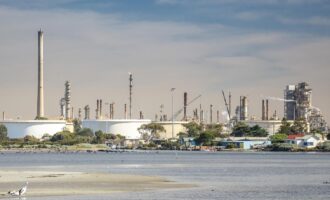Northern Oil Refinery is newest re-refinery in Australia
By Alison Gaines
In June 2014, Northern Oil Refinery (NOR) at Yarwun, near Gladstone in Queensland, Australia, began operations. The re-refinery is a partnership between Southern Oil and J.J. Richards & Sons. In what it calls a “cradle-to-cradle” process, Southern Oil recycles used lube oils, recovering 99% of the lube oil component of waste oil and re-introducing the re-refined oil into the market.
This is Southern Oil’s second re-refinery, the first being at Wagga Wagga in New South Wales, which has been re-refining since 2001, recycling 8% of Australia’s waste oil. The new plant refines about half of Queensland’s waste oil. It has the potential to process all of the northeastern state’s waste oil or 30% of Australia’s annual lube oil production. In December, the company produced its ten millionth litre (ML) of re-refined oil.
According to Tim Rose, managing director of Southern Oil, NOR can process about 40 ML of waste oil and produce 24 ML of re-refined product per year. Although the plant has demonstrated its ability to work at full nameplate capacity, because of feedstock availability, it is only operating at 40%. Now that NOR is operational, Southern Oil is sourcing more waste oil to process.
Under its agreement with Southern Oil, J.J. Richards & Sons is responsible for collecting waste oil from waste oil generator sites, such as mines, truck fleets, heavy vehicle operators and local governments, and taking it to an aggregation facility for initial treatment before it is transported to the re-refinery. Waste oil collection does not cost more than other disposal methods, he says.

When speaking about its process, Southern Oil is quick to point out that re-refining waste oil is still a novelty in Australia and thus, not widely understood. For instance, burning is considered recycling. “It is not,” Rose says. “Energy recovery is not the same as recycling.” Re-refining produces one-eighth the carbon footprint that burning produces, he adds.
The steps to produce re-refined base oil include dewatering, defueling, demineralization, vacuum distillation and distillate treatment. The whole process turns black waste oil that contains many contaminants into clear base oil.
According to information on Southern Oil’s website, its re-refining process produces 61 litres of base oil or every 100 litres of waste lube oil. There are other byproducts besides lube oil; Southern Oil sells the byproducts, except for sour water, as fuel. In that sense, the process produces little waste and converts 99% of the waste oil into a saleable product.
Byproducts besides base oil and water include light-end fuels, residual additives and contaminants, such as polynuclear aromatic hydrocarbons (PAHs) and dioxins and extracts, such as aromatics.
Southern Oil then sells the re-refined base oil across Australia. Third-party buyers blend it with additives to make engine, hydraulic, gear and transmission oils.
Rose says that J.J. Richards & Sons has an oily water treatment plant in Wacol, which he calls “a major step towards closing the recycling loop on waste oil.” The plant processes mixtures of water, fuel oils, hydraulic oils, detergents and additives. By separating the waste oil from the oily water into distinct waste streams, the oil that is recovered becomes the feedstock for NOR.
Southern Oil produces three viscosity grades: SORB015, a light base oil, medium-light SORB032 and a heavy grade, SORB052. Currently, Southern Oil only produces Group I base oil. However, according to Rose, Southern Oil is working with the Commonwealth Scientific and Industrial Research Organisation (CSIRO), which is Australia’s national science agency, on a process that, by removing more sulphur from the product, could produce a base oil that meets Group II specifications. He says that the team has come up with a process that will be undergoing trials soon.
Group I oils have a relatively high level of sulphur and aromatics, as well as a higher viscosity index. They are primarily used in industrial applications while Groups II and III are considered “premium” or “high performing” and are used more frequently in automotive applications.
“Our current base oil products meet Group I category, and while the domestic and international market for them remains strong, demand is expected to move to higher quality Group II oils in the future,” says Southern Oil Research and Development Manager Dick Dexter.
Although re-refineries, such as Southern Oil, only satisfy a small portion of Australia’s base oil demand, that number is expected to grow as feedstock supply availability grows. Oil recovery and recycling are making a clear impact in reducing the industry’s carbon footprint and in reducing foreign base oil imports. Accordingly, Australian companies like Southern Oil are anxious to expand.







